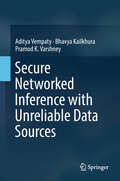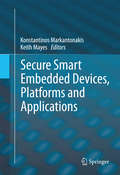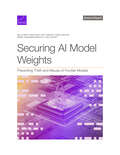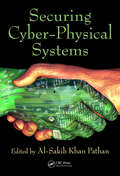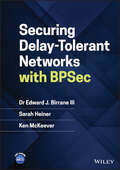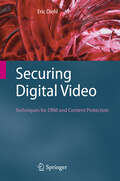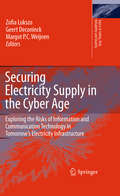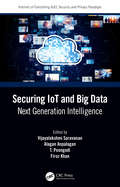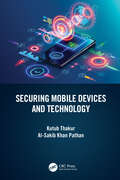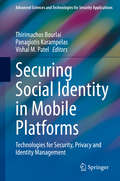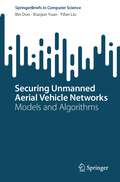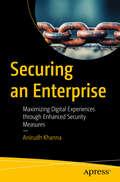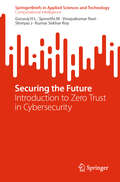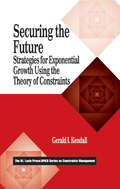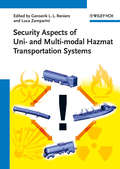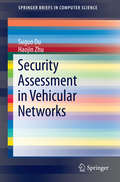- Table View
- List View
Secure Integrated Circuits and Systems
by Ingrid M.R. VerbauwhedeOn any advanced integrated circuit or "system-on-chip" there is a need for security. In many applications the actual implementation has become the weakest link in security rather than the algorithms or protocols. The purpose of the book is to give the integrated circuits and systems designer an insight into the basics of security and cryptography from the implementation point of view. As a designer of integrated circuits and systems it is important to know both the state-of-the-art attacks as well as the countermeasures. Optimizing for security is different from optimizations for speed, area, or power consumption. It is therefore difficult to attain the delicate balance between the extra cost of security measures and the added benefits.
Secure Networked Inference with Unreliable Data Sources
by Aditya Vempaty Bhavya Kailkhura Pramod K. VarshneyThe book presents theory and algorithms for secure networked inference in the presence of Byzantines. It derives fundamental limits of networked inference in the presence of Byzantine data and designs robust strategies to ensure reliable performance for several practical network architectures. In particular, it addresses inference (or learning) processes such as detection, estimation or classification, and parallel, hierarchical, and fully decentralized (peer-to-peer) system architectures. Furthermore, it discusses a number of new directions and heuristics to tackle the problem of design complexity in these practical network architectures for inference.
Secure Quantum Network Coding Theory
by Tao Shang Jianwei LiuThis is the first book on secure quantum network coding, which integrates quantum cryptography into quantum communication. It summarizes the main research findings on quantum network coding, while also systematically introducing readers to secure quantum network coding schemes. With regard to coding methods, coding models and coding security, the book subsequently provides a series of quantum network coding schemes based on the integration of quantum cryptography into quantum communication. Furthermore, it describes the general security analysis method for quantum cryptographic protocols. Accordingly, the book equips readers with effective tools for researching and applying quantum network coding.
Secure Smart Embedded Devices, Platforms and Applications
by Konstantinos Markantonakis Keith MayesNew generations of IT users are increasingly abstracted from the underlying devices and platforms that provide and safeguard their services. As a result they may have little awareness that they are critically dependent on the embedded security devices that are becoming pervasive in daily modern life. Secure Smart Embedded Devices, Platforms and Applications provides a broad overview of the many security and practical issues of embedded devices, tokens, and their operation systems, platforms and main applications. It also addresses a diverse range of industry/government initiatives and considerations, while focusing strongly on technical and practical security issues. The benefits and pitfalls of developing and deploying applications that rely on embedded systems and their security functionality are presented. A sufficient level of technical detail to support embedded systems is provided throughout the text, although the book is quite readable for those seeking awareness through an initial overview of the topics. This edited volume benefits from the contributions of industry and academic experts and helps provide a cross-discipline overview of the security and practical issues for embedded systems, tokens, and platforms. It is an ideal complement to the earlier work, Smart Cards Tokens, Security and Applications from the same editors.
Secure and Digitalized Future Mobility: Shaping the Ground and Air Vehicles Cooperation
by Omprakash Kaiwartya Yue Cao Tiancheng LiThis book discusses the recent advanced technologies in Intelligent Transportation Systems (ITS), with a view on how Unmanned Aerial Vehicles (UAVs) cooperate with future vehicles. ITS technologies aim to achieve traffic efficiency and advance transportation safety and mobility. Known as aircrafts without onboard human operators, UAVs are used across the world for civilian, commercial, as well as military applications. Common deployment include policing and surveillance, product deliveries, aerial photography, agriculture, and drone racing. As the air-ground cooperation enables more diverse usage, this book addresses the holistic aspects of the recent advanced technologies in ITS, including Information and Communication Technologies (ICT), cyber security, and service management from principle and engineering practice aspects. This is achieved by providing in-depth study on several major topics in the fields of telecommunications, transport services, cyber security, and so on. The book will serve as a useful text for transportation, energy, and ICT societies from both academia and industrial sectors. Its broad scope of introductory knowledge, technical reviews, discussions, and technology advances will also benefit potential authors.
Secure and Trusted Cyber Physical Systems: Recent Approaches and Future Directions (Smart Sensors, Measurement and Instrumentation #43)
by Ernest Foo Shantanu Pal Zahra JadidiThis book highlights the latest design and development of security issues and various defences to construct safe, secure and trusted Cyber-Physical Systems (CPS). In addition, the book presents a detailed analysis of the recent approaches to security solutions and future research directions for large-scale CPS, including its various challenges and significant security requirements. Furthermore, the book provides practical guidance on delivering robust, privacy, and trust-aware CPS at scale. Finally, the book presents a holistic insight into IoT technologies, particularly its latest development in strategic applications in mission-critical systems, including large-scale Industrial IoT, Industry 4.0, and Industrial Control Systems. As such, the book offers an essential reference guide about the latest design and development in CPS for students, engineers, designers, and professional developers.
Secure and Trustworthy Cyberphysical Microfluidic Biochips: A practical guide to cutting-edge design techniques for implementing secure and trustworthy cyberphysical microfluidic biochips
by Krishnendu Chakrabarty Jack Tang Mohamed Ibrahim Ramesh KarriThis book describes novel hardware security and microfluidic biochip design methodologies to protect against tampering attacks in cyberphysical microfluidic biochips (CPMBs). It also provides a general overview of this nascent area of research, which will prove to be a vital resource for practitioners in the field.This book shows how hardware-based countermeasures and design innovations can be a simple and effective last line of defense, demonstrating that it is no longer justifiable to ignore security and trust in the design phase of biochips.
Secure, Low-Power IoT Communication Using Edge-Coded Signaling
by Ibrahim (Abe) Elfadel Shahzad MuzaffarThis book discusses single-channel, device-to-device communication in the Internet of Things (IoT) at the signal encoding level and introduces a new family of encoding techniques that result in significant simplifications of the communication circuitry. These simplifications translate into lower power consumption, smaller form factors, and dynamic data rates that are tolerant to clock discrepancies between transmitter and receiver. Readers will be introduced to signal encoding that uses edge-coded signaling, based on the coding of binary data as counts of transmitted pulses. The authors fully explore the far-reaching implications of these novel signal-encoding techniques and illustrate how their usage can help minimize the need for complex circuitries for either clock and data recovery or duty-cycle correction. They also provide a detailed description of a complete ecosystem of hardware and firmware built around edge-code signaling. The ecosystem comprises an application-specific processor, automatic protocol configuration, power and data rate management, cryptographic primitives, and automatic failure recovery modes. The innovative IoT communication link and its associated ecosystem are fully in line with the standard IoT requirements on power, footprint, security, robustness, and reliability.
Securing AI Model Weights: Preventing Theft and Misuse of Frontier Models
by Sella Nevo Dan Lahav Ajay Karpur Yogev Bar-On Henry-Alexander Bradley Jeff AlstottAs frontier artificial intelligence (AI) models—that is, models that match or exceed the capabilities of the most advanced models at the time of their development—become more capable, protecting them from theft and misuse will become more important. The authors of this report explore what it would take to protect model weights—the learnable parameters that encode the core intelligence of an AI—from theft by a variety of potential attackers.
Securing America's Passenger-Rail Systems
by Brian A. Jackson K. Jack Riley Jeremy M. Wilson Paul Steinberg Mel EismanU.S. communities depend on reliable, safe, and secure rail systems. Each weekday, more than 12 million passengers take to U.S. railways. This book explains a framework for security planners and policymakers to guide cost-effective rail-security planning, specifically for the risk of terrorism. Risk is a function of threat, vulnerability, and consequences. This book focuses on addressing vulnerabilities and limiting consequences.
Securing Cyber-Physical Systems
by Al-Sakib Khan PathanThink about someone taking control of your car while you're driving. Or, someone hacking into a drone and taking control. Both of these things have been done, and both are attacks against cyber-physical systems (CPS). Securing Cyber-Physical Systems explores the cybersecurity needed for CPS, with a focus on results of research and real-world deploy
Securing Delay-Tolerant Networks with BPSec
by Edward J. Birrane III Sarah Heiner Ken McKeeverSecuring Delay-Tolerant Networks with BPSec One-stop reference on how to secure a Delay-Tolerant Network (DTN), written by experienced industry insiders Securing Delay-Tolerant Networks with BPSec answers the question, “How can delay-tolerant networks be secured when operating in environments that would otherwise break many of the common security approaches used on the terrestrial Internet today?” The text is composed of three sections: (1) security considerations for delay-tolerant networks, (2) the design, implementation, and customization of the BPSec protocol, and (3) how this protocol can be applied, combined with other security protocols, and deployed in emerging network environments. The text includes pragmatic considerations for deploying BPSec in both regular and delay-tolerant networks. It also features a tutorial on how to achieve several important security outcomes with a combination of security protocols, BPSec included. Overall, it covers best practices for common security functions, clearly showing designers how to prevent network architecture from being over-constrained by traditional security approaches. Written by the lead author and originator of the BPSec protocol specification, Securing Delay-Tolerant Networks (DTNs) with BPSec includes information on: The gap between cryptography and network security, how security requirements constrain network architectures, and why we need something different DTN stressing conditions, covering intermittent connectivity, congested paths, partitioned topologies, limited link state, and multiple administrative controls Securing the terrestrial internet, involving a layered approach to security, the impact of protocol design on security services, and securing the internetworking and transport layers A delay-tolerant security architecture, including desirable properties of a DTN secure protocol, fine-grained security services, and protocol augmentation Securing Delay-Tolerant Networks (DTNs) with BPSec is a one-stop reference on the subject for any professional operationally deploying BP who must use BPSec for its security, including software technical leads, software developers, space flight mission leaders, network operators, and technology and product development leaders in general.
Securing Digital Video: Techniques for DRM and Content Protection
by Eric DiehlContent protection and digital rights management (DRM) are fields that receive a lot of attention: content owners require systems that protect and maximize their revenues; consumers want backwards compatibility, while they fear that content owners will spy on their viewing habits; and academics are afraid that DRM may be a barrier to knowledge sharing. DRM technologies have a poor reputation and are not yet trusted. This book describes the key aspects of content protection and DRM systems, the objective being to demystify the technology and techniques. In the first part of the book, the author builds the foundations, with sections that cover the rationale for protecting digital video content; video piracy; current toolboxes that employ cryptography, watermarking, tamper resistance, and rights expression languages; different ways to model video content protection; and DRM. In the second part, he describes the main existing deployed solutions, including video ecosystems; how video is protected in broadcasting; descriptions of DRM systems, such as Microsoft's DRM and Apple's FairPlay; techniques for protecting prerecorded content distributed using DVDs or Blu-ray; and future methods used to protect content within the home network. The final part of the book looks towards future research topics, and the key problem of interoperability. While the book focuses on protecting video content, the DRM principles and technologies described are also used to protect many other types of content, such as ebooks, documents and games. The book will be of value to industrial researchers and engineers developing related technologies, academics and students in information security, cryptography and media systems, and engaged consumers.
Securing Electricity Supply in the Cyber Age: Exploring the Risks of Information and Communication Technology in Tomorrow's Electricity Infrastructure
by Margot P. Weijnen Zofia Lukszo Geert DeconinckThe electricity infrastructure is one of society's most critical infrastructures. The complexity of the electricity infrastructure system is increasing quickly, due to the increasing intensity of market-based power exchanges between electricity systems, the associated market restructuring and an increasing share of decentralized generation. As a consequence, the organizational complexity of power systems has exploded. At the same time, there is a shift in public and societal goals towards low-carbon and sustainable power generation. This will eventually require a drastic transformation of the industry. Increasingly, ICT is being depended upon for managing this infrastructure, for technical control and operation and for facilitating markets. A recent example is demand-side management, based on detailed metering of consumption and decentralized electricity generation. The mutual dependence of the electricity and the ICT infrastructures raises challenging questions in the areas of dependability, security and resilience. Examples include vulnerability to (cyber) attacks, avoiding and repairing technical failures and protecting data confidentiality, while guaranteeing accessibility. Therefore, better models and methods for protection against exploits of system vulnerabilities, whether accidental or intentional such as in cyber attacks, are called for. To address the above mentioned problems an advanced research workshop: "Electricity security in the cyber age: Managing the increasing dependence of the electricity infrastructure on ICT" was organized in the Netherlands in May 2009. The objective of the workshop was to contribute to the security of current and future electricity infrastructures by analyzing the risks that are caused by the increasing reliance upon ICT and investigating options for managing these risks. The book presents the contributions to the workshop by distinguished invited keynote speakers and participants from the international scientific and industrial community.
Securing IoT and Big Data: Next Generation Intelligence (Internet of Everything (IoE))
by Alagan Anpalagan T. Poongodi Vijayalakshmi Saravanan Firoz KhanThis book covers IoT and Big Data from a technical and business point of view. The book explains the design principles, algorithms, technical knowledge, and marketing for IoT systems. It emphasizes applications of big data and IoT. It includes scientific algorithms and key techniques for fusion of both areas. Real case applications from different industries are offering to facilitate ease of understanding the approach. The book goes on to address the significance of security algorithms in combing IoT and big data which is currently evolving in communication technologies. The book is written for researchers, professionals, and academicians from interdisciplinary and transdisciplinary areas. The readers will get an opportunity to know the conceptual ideas with step-by-step pragmatic examples which makes ease of understanding no matter the level of the reader.
Securing Mobile Devices and Technology
by Al-Sakib Khan Pathan Kutub ThakurThis book describes the detailed concepts of mobile security. The first two chapters provide a deeper perspective on communication networks, while the rest of the book focuses on different aspects of mobile security, wireless networks, and cellular networks. This book also explores issues of mobiles, IoT (Internet of Things) devices for shopping and password management, and threats related to these devices. A few chapters are fully dedicated to the cellular technology wireless network. The management of password for the mobile with the modern technologies that helps on how to create and manage passwords more effectively is also described in full detail. This book also covers aspects of wireless networks and their security mechanisms. The details of the routers and the most commonly used Wi-Fi routers are provided with some step-by-step procedures to configure and secure them more efficiently. This book will offer great benefits to the students of graduate and undergraduate classes, researchers, and also practitioners.
Securing Social Identity in Mobile Platforms: Technologies for Security, Privacy and Identity Management (Advanced Sciences and Technologies for Security Applications)
by Vishal M. Patel Panagiotis Karampelas Thirimachos BourlaiThe book presents novel research in the areas of social identity and security when using mobile platforms. The topics cover a broad range of applications related to securing social identity as well as the latest advances in the field, including the presentation of novel research methods that are in the service of all citizens using mobile devices. More specifically, academic, industry-related and government (law enforcement, intelligence and defence) organizations, will benefit from the research topics of this book that cover the concept of identity management and security using mobile platforms from various perspectives, i.e. whether a user navigates to social media, accesses their own phone devices, access their bank accounts, uses online shopping service providers, accesses their personal documents or accounts with valuable information, surfs the internet, or even becomes a victim of cyberattacks. In all of the aforementioned cases, there is a need for mobile related technologies that protect the users’ social identity and well-being in the digital world, including the use of biometrics, cybersecurity software and tools, active authentication and identity anti-spoofing algorithms and more.
Securing Unmanned Aerial Vehicle Networks: Models and Algorithms (SpringerBriefs in Computer Science)
by Xiaojun Yuan Bin Duo Yifan LiuThis book focuses on the model and algorithm aspects of securing Unmanned Aerial Vehicle Networks (UAV). To equip readers with the essential knowledge required for conducting research in this field, it covers the foundational concepts of this topic as well. This book also offers a detailed insight into UAV networks from the physical layer security point of view.The authors discuss the appropriate channel models for characterizing various propagation environments that UAV networks are exposed. The state-of-the-art technologies, such as UAV trajectory design, cooperative jamming and reconfigurable intelligent surfaces are covered. The corresponding algorithms for significantly improving the security of UAV networks, along with practical case studies on topics such as energy-efficient and secure UAV networks, elevation angle-distance trade-off for securing UAV networks and securing UAV networks with the aid of reconfigurable intelligent surfaces are presented as well. Last, this book outlines the future challenges and research directions to facilitate further studies on secure UAV networks. This book is suitable reading for graduate students and researchers who are interested in the research areas of UAV networking and communications, IoT security, and physical layer security in wireless networks. Professionals working within these related fields will also benefit from this book.
Securing an Enterprise: Maximizing Digital Experiences through Enhanced Security Measures
by Anirudh KhannaDive into the world of digital security and navigate its intricate landscape. In an era where digital reliance is ubiquitous, the need for robust cybersecurity measures has never been more pressing. Part of author Saurav Bhattacharya’s trilogy that covers the essential pillars of digital ecosystems—security, reliability, and usability—this book sheds light on the dynamic challenges posed by cyber threats, advocating for innovative security solutions that safeguard users while upholding their digital freedoms. Against the backdrop of rapid technological advancement and escalating cyber threats, this book addresses pressing security concerns at the forefront of our digital era. You’ll learn that trust plays a pivotal role in fostering a secure digital environment, enabling individuals and organizations to flourish without fear of malicious exploits. With transformative technologies like AI, blockchain, and quantum computing on the horizon, understanding and addressing cybersecurity fundamentals is essential for traversing the evolving digital landscape. Securing an Enterprise is your roadmap towards a future where technology aligns with humanity, fostering a more equitable, secure, and interconnected world. What You will Learn Explore advanced methodologies and innovative approaches to bolster cybersecurity Understand the potential impacts of the advancements on security Provide strategic guidance on adapting to security changes to ensure sustainability Take a holistic approach in reviewing security Who This Book Is For Cybersecurity Professionals, Technology Developers and Engineers
Securing the Digital World: A Comprehensive Guide to Multimedia Security
by Aditya Kumar Sahu Subhrajyoti DebSecuring the Digital World: A Comprehensive Guide to Multimedia Security is indispensable reading in today's digital age. With the outbreak of digital range and ever-evolving cyber threats, the demand to protect multimedia data has never been more imperative. This book provides comprehensive research on multimedia information security and bridges the gap between theoretical bases and practical applications.Authored by leading experts in the area, the book focusses on cryptography, watermarking, steganography and its advanced security solution while keeping a clear and engaging description and sets this book apart in its capability to make complex concepts accessible and practical, making it an incalculable resource for beginners and seasoned professionals alike.Key Features: Detailed study of encryption techniques, including encryption and decryption methods adapted to multimedia data A comprehensive discussion of techniques for embedding and detecting hidden information in digital media A survey of the latest advances in multimedia security, including quantum cryptography and blockchain applications Real-world case studies and illustrations that demonstrate the application of multimedia information security techniques in various initiatives Contributions from computer science and information technology experts offer a comprehensive perspective on multimedia security This book is an invaluable help for cybersecurity professionals, IT professionals, and computer and information technology students. Securing the Digital World equips readers with the information and tools required to safeguard multimedia content in a cyber-spatiality full of security challenges.
Securing the Future: Introduction to Zero Trust in Cybersecurity (SpringerBriefs in Applied Sciences and Technology)
by Vinayakumar Ravi Gururaj H L Spoorthi M Shreyas J Kumar Sekhar RoyThis book delves into the transformative concept of Zero Trust, challenging traditional notions of network security and advocating for a paradigm shift in cybersecurity strategies. Beginning with an exploration of the fundamentals behind Zero Trust and its core principles, the book progresses to practical insights on implementing Zero Trust networks and extending its principles to cloud environments. It addresses the crucial aspects of compliance and governance within the Zero Trust framework and provides real-world applications and case studies showcasing successful Zero Trust implementations. Furthermore, it underscores the importance of cultivating Zero Trust awareness throughout organizational culture to fortify security measures effectively. Highlighting both the challenges and the future potential of Zero Trust, this book offers a roadmap for organizations seeking to bolster their cybersecurity defenses amidst an evolving threat landscape.
Securing the Future: Strategies for Exponential Growth Using the Theory of Constraints (The CRC Press Series on Constraints Management)
by Gerald I. KendallToday's managers encounter tremendous resistance in getting others to buy-in to change. The ongoing rounds of downsizing and upheaval have taken their toll, leaving a legacy of skepticism. Therefore, managers must not only have ideas, but must be experts at "selling" the correct answers, information, and measurements to address issues of change.
Security Analytics for the Internet of Everything
by Al-Sakib Khan Pathan Mohiuddin Ahmed Abu S. S. M. Barkat UllahSecurity Analytics for the Internet of Everything compiles the latest trends, technologies, and applications in this emerging field. It includes chapters covering emerging security trends, cyber governance, artificial intelligence in cybersecurity, and cyber challenges. Contributions from leading international experts are included. The target audience for the book is graduate students, professionals, and researchers working in the fields of cybersecurity, computer networks, communications, and the Internet of Everything (IoE). The book also includes some chapters written in a tutorial style so that general readers can easily grasp some of the ideas.
Security Aspects of Uni- and Multimodal Hazmat Transportation Systems
by Genserik L. Reniers Luca ZampariniWritten in a clear language, for use by scholars, managers and decisionmakers, this practical guide to the hot topic is unique in treating thesecurity aspects of hazmat transportation from both uni-modal and multi-modal perspectives. To begin with, each transport mode and itsrelation to security vulnerability, analyses, figures, and approaches is discussed separately. Secondly, the optimization process of a hazmatsupply chain is examined from a holistic, integrated viewpoint. Finally, the book discusses and compares the various hazmat transport securitypolicies and strategies adopted in various regions around the world. The result is a must-have source of high-quality information includingmany case studies.
Security Assessment in Vehicular Networks
by Suguo Du Haojin ZhuThis book presents several novel approaches to model the interaction between the attacker and the defender and assess the security of Vehicular Ad Hoc Networks (VANETs). The first security assessment approach is based on the attack tree security assessment model, which leverages tree based methods to analyze the risk of the system and identify the possible attacking strategies the adversaries may launch. To further capture the interaction between the attacker and the defender, the authors propose to utilize the attack-defense tree model to express the potential countermeasures which could mitigate the system. By considering rational participants that aim to maximize their payoff function, the brief describes a game-theoretic analysis approach to investigate the possible strategies that the security administrator and the attacker could adopt. A phased attack-defense game allows the reader to model the interactions between the attacker and defender for VANET security assessment. The brief offers a variety of methods for assessing the security of wireless networks. Professionals and researchers working on the defense of VANETs will find this material valuable.

